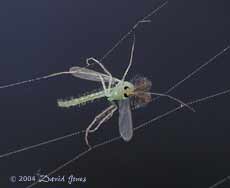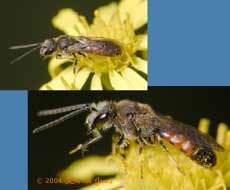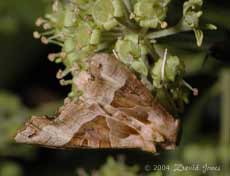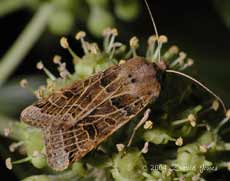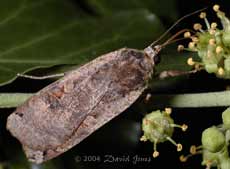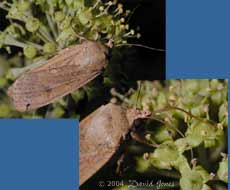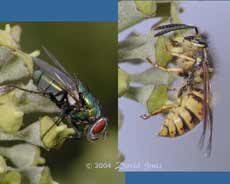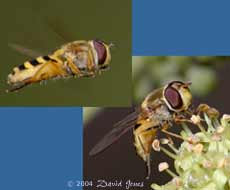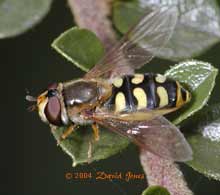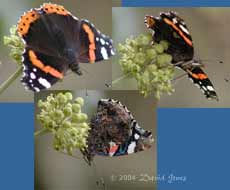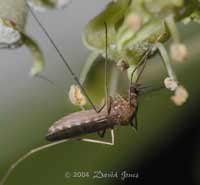Go to latest entry on this page..................Go to previous entry19 September - Well, it appears that the Martins have left us. There was no sign of them this morning and I haven't heard or seen any in the skies above us today.
Today it was mainly cloudy. This morning I heard a lot of twittering in the garden and found that there were Goldfinches in the Birch tree. There were five of them, including juveniles, and they were feeding on the seedheads.
This moth was photographed outside the kitchen door last night. My first look through the guide books has failed to come up with an ID for it. In the right hand image, notice its up-turned abdomen. Thanks to Janice Green and Tim Norriss (Hampshire recorder of moths) for identifying it as a common marbled carpet, chloroclysta truncata.
I looked at the web several times during the morning, and it was being successful in supplying food for its builder. However, the spider seems choosy about what it eats. After this small gnat (?) was caught on the web it was still alive two hours later - perhaps it was too small for the spider to bother with! Like the moth, it doesn't appear in my guide books. 21 September - A bright, sunny morning and quite windy, although nowhere near as it was yesterday.
It is very similar to Andrena labiata although the abdomen looks a bit too slender.
There have been few ladybird sightings here during the late summer. This one appears to be a melanic version of a six-spot ladybird (Adalia bipunctata) and is the first ladybird I have seen on the Ivy.
The first of the moths seen last night was this Angle Shades (Phlogophora meticulosa).
Next was this individual with its bold wing markings. I don't recollect seeing one of these here before. A look though my books fails to come up with a good match, although it does have a passing resemblance to a Feathered Gothic Tholera decimalis, although the location is wrong. Tim Norris has again come to my rescue, identifying it as a Lunar Underwing moth (which doesn't appear in any of my books, but which is widespread).
The next two moths look very similar, although there are enough differences for me to put both images in. The nearest match in my guides is a Large Yellow Underwing. Next time I see one I shall have to disturb it to see if its hind wings are indeed partially yellow.
This last one was lighter and much more uniform in colour, and with only a feint marking on the fore-wing. It is also a Large Yellow Underwing, a species which is very variable.
This afternoon it was cool and quite windy again. The main visitors to the Ivy were social wasps and lots of flies including Bluebottles and Greenbottles like this one. Flies don't usually impress Sheila, but even she had to agree that the colours on this one were impressive!
These two are very similar, except that I notice that the hind leg of the right-hand fly has dark areas on it. I think they are Lesser Banded Hoverflies. The left hand (nearly full-frame) image is the nearest I've got yet to a decent 'in flight' image of a hoverfly. Unfortunately it didn't appreciate having a lens just centimetres away from it and didn't stay for a second try.
There were several large droneflies about but they disappeared as soon as the camera got near. This one was far now cooperative as it rested before going to the Ivy. It's a large hoverfly and I think it is Scaeva pyrastri.
Mike Wall, whose website contains hundreds of moth images, has told me that it is a micro moth, called Epiphyas postvittana. It was 'accidentally introduced from Australia in the 1930s and is now widespread across southern England'. A last check of the Ivy at 10pm (still very breezy) revealed just two moths, an Angle Shades and another Large Yellow Underwing, similar to the second one pictured above.
On the Birch there were numerous Orange Ladybird larvae and several adults, two of which were newly emerged.
This butterfly is a regular Autumn visitor to the Ivy and I was wondering when the first one would appear - they usually wait for a sunny day. This one finally stopped to feed on my neighbour's side of the tree and I had to perch half on my step-ladder and half on the garden fence to grab these images as it opened its wings towards the sun every time there was a gap in the clouds.
23 September - There was a Red Admiral about again during a sunny period at lunchtime.
Tonight, I checked the Ivy around 9pm. The only moth I could see was a White Plume Moth but it fluttered off before I could photograph it. The only other insects that I could see were mosquitoes, which, like this one were gorging themselves on the sap.
24 September - A dry, somewhat cool day, and I've been busy with preparations for another short trip to Cornwall. Consequently there will be a gap in the diaries. During this last week there have been numerous reports of by-the-wind-sailors (Vallella vallella) being washed up in large numbers, mainly on the Northern Cornish coast. I've seen one report of some appearing on a beach on the Lizard, where we will be, so I shall be keeping my fingers crossed that I can see these creatures for the very first time. Hopefully there will be a chance to take some photographs of some in good condition. Back soon ......
|
|


